warning AUDI S4 2018 Owners Manual
[x] Cancel search | Manufacturer: AUDI, Model Year: 2018, Model line: S4, Model: AUDI S4 2018Pages: 403, PDF Size: 66.81 MB
Page 326 of 403
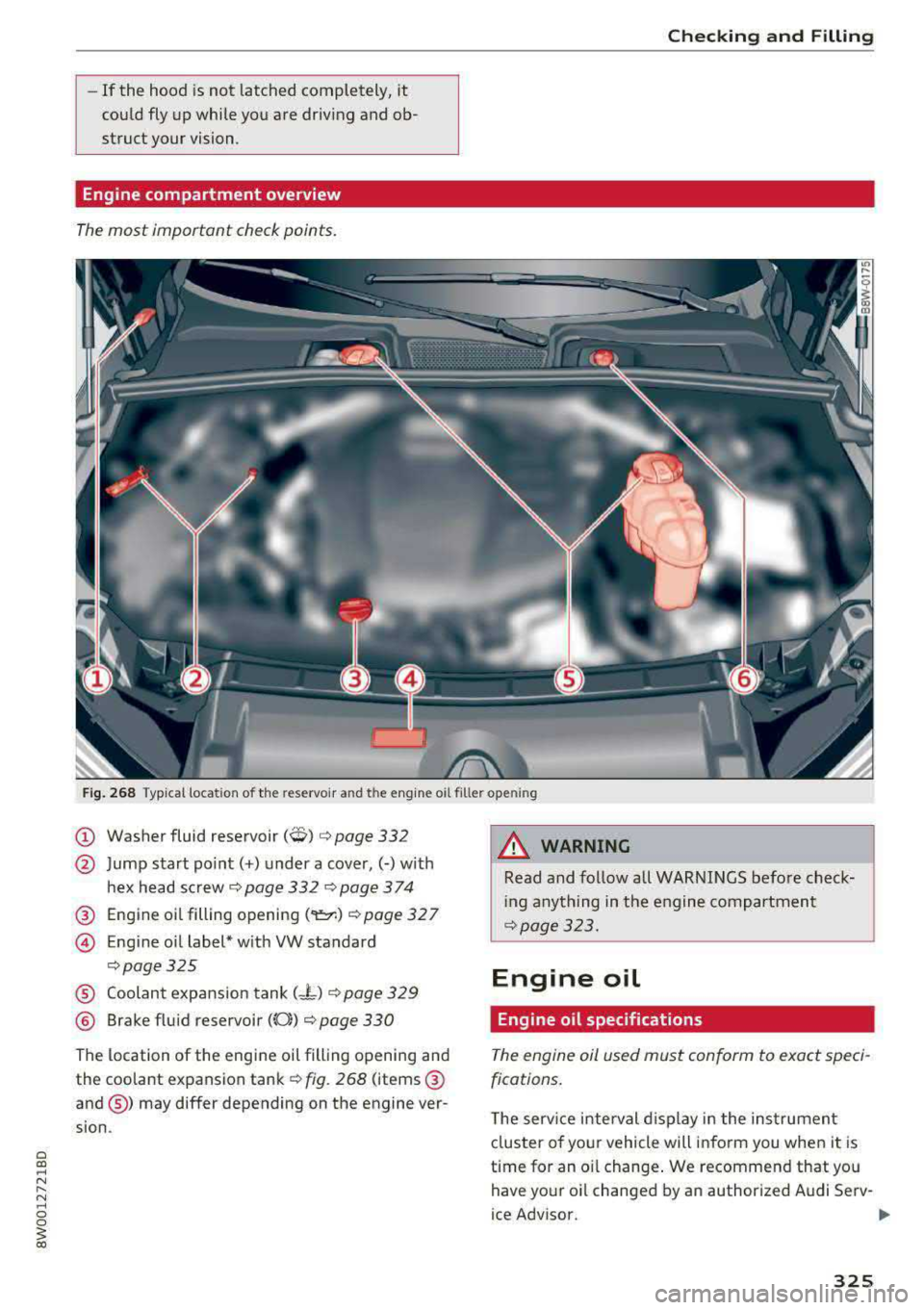
-If the hood is not latched completely, it
could fly up while you are driving and ob
struct your vision.
Engine compartment overview
The most important check points.
Checking and Filling
Fig. 268 Typical location of the reservoir a nd t he engine o il filler ope ning
(!) Washer fluid reservoir (O) c::> page 332
@ Jump start po int( +) under a cover,(-) w ith
hex head screw
¢page 332 c:>page 374
@ Engine oil filling opening (
c:> page325
® Coolant expansion tank (- L) c::> page 329
® Brake fluid reservoir ((0) c::> page 330
The location of the engine oil filling opening and
the coolant expansion tank ¢
fig. 268 (items@
and@) may differ depending on the engine ver
sion .
_& WARNING
-Read and follow all WARNINGS before check-
in g anything in the engine compartment
c:> page 323.
Engine oil
Engine oil specifications
The engine oil used must conform to exact speci
fications.
The service interval display in the instrument
cluster of your vehicle will inform you when it is
time for an oi l change . We recommend that you
have your oil changed by an authorized Audi Serv-
ice Advisor.
.,..
325
Page 327 of 403
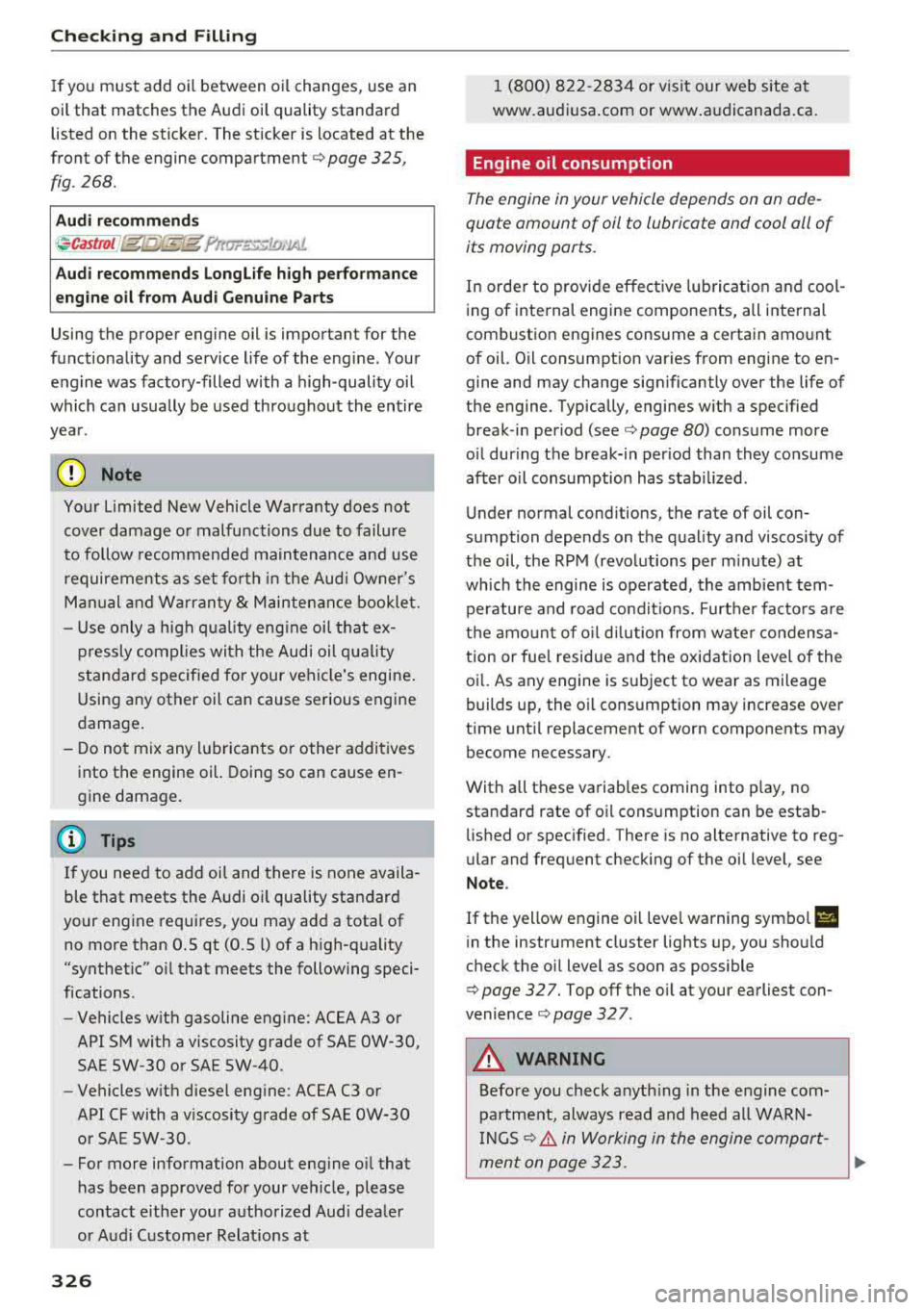
Check ing and F illing
I f you must add oi l between oi l changes, use an
oil that matches the Audi oi l quality standard
listed on the st icker. The sticker is located at the
front of the engine
compartment <=> page 325,
fig. 268.
Au di r ec omm end s
ocastrol i/g/g'fE:@t P'r(w.:::-..~J.D,'JAJ..
A udi r ecommends Longli fe high performa nce
e ngin e oil from Audi G enuin e Part s
Using the proper engine oil is important for the
functionality and service life of the eng ine. Your
engine was factory-filled with a h igh-quality oil
which can usually be used throughout the entire
yea r.
0 Note
Your Limited New Vehicle Warranty does not
cover damage o r malfunctions due to failure
to follow recommended maintenance and use
requirements as set fo rth in the Aud i Owner's
Man ual and Warranty
& Maintenance booklet.
- Use only a high qual ity eng ine oi l th at ex-
p ressly complies with the Audi oil q uality
standard specified for your vehicle's engine .
Using any other oil can cause se rious engine
damage .
- Do not mix any lubricants or other additives into the engine oil. Doing so can cause en
gine damage.
(D Tips
If you need to add oil and there is none availa
ble that meets the Audi oi l quality standard
your engine requi res, you may add a total of
no more than 0.5 qt (0.5 l) of a h igh-quality
"synthet ic" o il that meets the following speci
fications.
- Vehicles with gasoline eng ine: ACEA A3 or
API SM with a viscosity grade of SAE OW-30,
SAE 5W-30 or SAE 5W-40.
- Vehicles w ith diesel eng ine: ACEA C3 or
API CF with a v iscosity grade of SAE OW-30
or SAE 5W-30 .
- For more information about engine oi l that
has been approved for your vehicle, please
contact eithe r your authorized Aud i dealer
or Audi Custome r Relat ions at
326
1 (800) 822-2834 or visit our web site at
www.audi usa .com or www .audicanada .ca.
Engine oil consumption
The engine in your vehicle depends on an ade
quate amount of oil to lubricate and cool all of
its moving ports.
In order to prov ide effect ive lub ricat ion and cool
ing of internal engine components, all internal
combustion engines consume a certain amount
of oil. Oil consumption var ies from engine to en
gine and may change significantly over the life of
the engine. Typically, engines w ith a specified
break-in period
(see<=> page 80) consume more
o il dur ing the break-in per iod than they consume
after o il consumption has stabi lized .
U nder normal cond itions, the rate of oil con
sumption depends on the quality and viscos ity of
the oil, the RPM (revolutions per m inute) at
wh ich the engine is operated, the amb ient tem
perature and road condit ions. Furthe r facto rs a re
t h e amo unt of o il di lution from wate r condensa
t ion or fue l residue a nd the oxidat ion level of the
oi l. As any engine is subject to wear as mileage
builds up, the oi l consumption may increase ove r
ti me until replacement of worn components may
become necessary.
With a ll these variab les coming into p lay, no
standard rate of oil cons umption can be estab
li shed or specified . There is no alternative to reg
ular and frequent checking of the oil level, see
Note .
If the yellow engine oil leve l warning symbo l El
in the instrument cluster lights up, you should
check the o il level as soon as possible
<=> page 32 7. Top off the o il at your earliest con
venience
<=> page 32 7.
A WARNING
Before you check anyth ing in the e ngine com
partment, always read and heed all WARN
I NGS<=> .&. in Working in the engine compart-
ment on page 323.
1iJ>,
Page 328 of 403
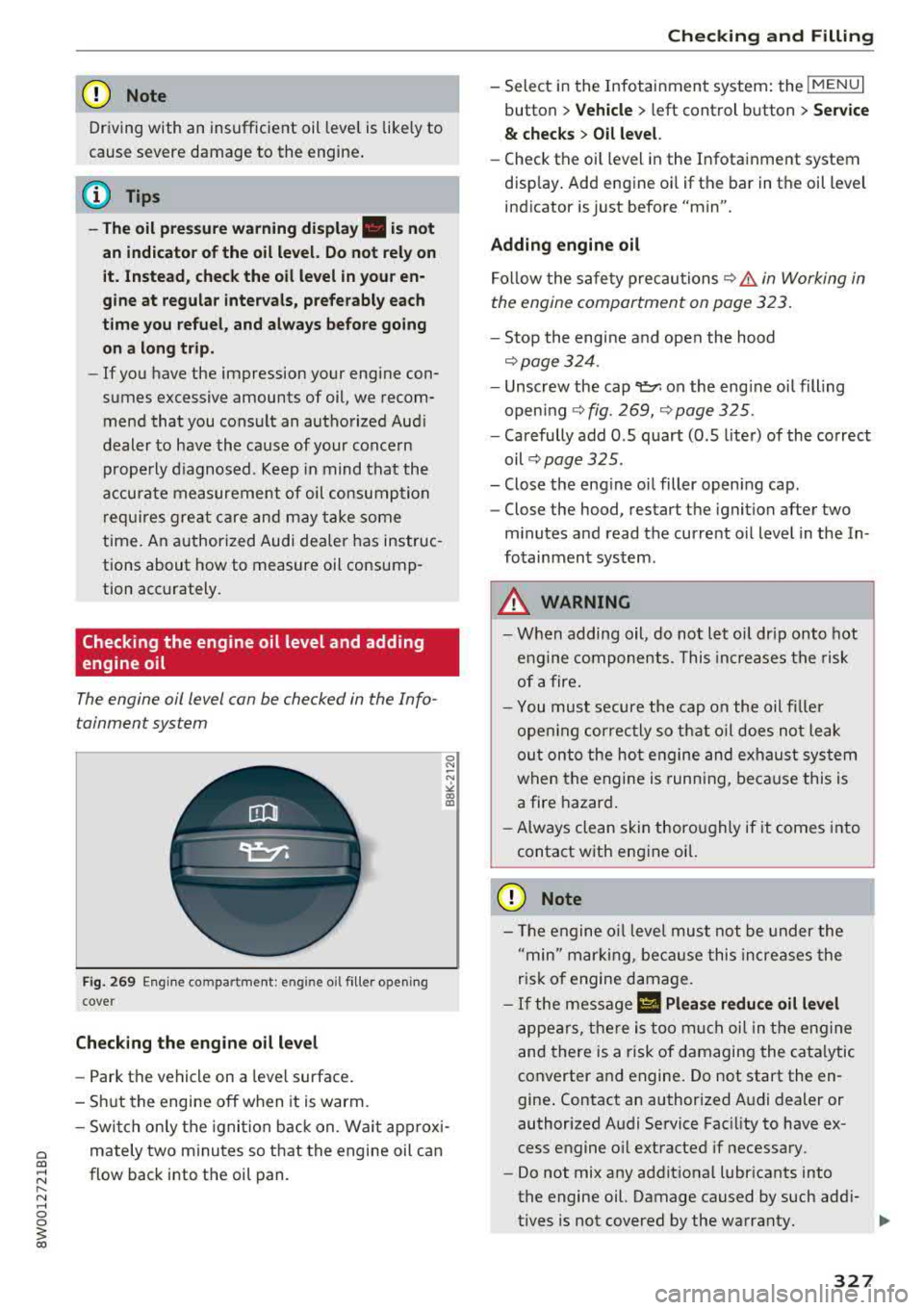
a co .... N ,....
N .... 0 0
3 co
(D Note
Driving with an insufficient oil level is likely to
cause severe damage to the engine.
@ Tips
-The oil pressure warning display. is not
an indicator of the oil level. Do not rely on
it. Instead, check the oil level in your en
gine at regular intervals, preferably each
time you refuel, and always before going
on a long trip.
-If you have the impression your engine con
sumes excessive amounts of oil, we recom
mend that you consult an authorized Audi
dealer to have the cause of your concern
properly diagnosed. Keep in mind that the
accurate measurement of oil consumption
requires great care and may take some
time. An authorized Audi dealer has instruc
tions about how to measure oil consump
tion accurately.
Checking the engine oil level and adding
engine oil
The engine oil level can be checked in the Info
tainment system
Fig. 269 Engine compa rtment: eng ine oil filler opening
cove r
Checking the engine oil level
- Park the vehicle on a level surface.
- Shut the engine off when it is warm.
0 N
-N
" 00 IX)
-Switch only the ignition back on. Wait approxi-
mately two minutes so that the engine oil can
flow back into the oil pan .
Checking and Filling
- Select in the Infotainment system: the !MENUI
button > Vehicle > left control button > Service
& checks > Oil level.
-Check the oil level in the Infotainment system
display. Add engine oil if the bar in the oil level
indicator is just before "min".
Adding engine oil Follow the safety precautions
~&. in Working in
the engine compartment on page 323.
- Stop the engine and open the hood
~page 324 .
-Unscrew the cap~ on the engine oil filling
opening
~ fig. 269, Qpage 325.
- Carefully add O .S quart (O .S liter) of the correct
oil
~ page 325.
- Close the engine oil filler opening cap.
- Close the hood, restart the ignition after two
minutes and read the current oil level in the In
fotainment system.
A WARNING ...__ --When adding oil, do not let oil drip onto hot
engine components. This increases the risk
of afire.
-You must secure the cap on the oil filler
opening correctly so that oil does not leak
out onto the hot engine and exhaust system
when the engine is running, because this is
a fire hazard.
-Always clean skin thoroughly if it comes into
contact with engine oil.
0 Note
- The engine oil level must not be under the
"min" marking, because this increases the
risk of engine damage.
- If the message II Please reduce oil level
appears, there is too much oil in the engine
and there is a risk of damaging the catalytic
converter and engine. Do not start the en
gine. Contact an authorized Audi dealer or
authorized Audi Service Facility to have ex
cess engine oil extracted if necessary.
- Do not mix any additional lubricants into
the engine oil. Damage caused by such addi-
tives is not covered by the warranty.
IJJ>
327
Page 329 of 403

Check ing and F illing
@ For the sake of the environment
- Oil should never enter the sewer system or
come into contact with the gro und.
- Pay attention to legal requirements when
disposing of empty oil containers .
@ Tips
- The oil leve l indicator in the d isplay is only
an informationa l disp lay .
If the oil leve l is
too low, a minimum oil warning appea rs in
the instrument cluster. Add oil and close
the hood . The current oil level is displayed
i n the instrument cluster the next t ime the
i gnition is switched on .
- The engine oil consumption may be up to
0 .5 quart/600 miles (0 .5 liter/1,000 km),
depend ing on driving style a nd operating
cond itions . Consumption may be higher
d ur in g the first 3,000 miles (5,000 km). Be
cause of t his, the engi ne oil level m ust be
chec ked regular ly.
It would be best to check
each time you ref uel your veh icle and before
l ong drives.
Changing the engine oil
We recommend that hove your oil changed by an
authorized Audi dealer or a qualified service sta
tion .
Before you c heck a nyth ing in the eng ine compart
men t,
alway s read and heed all WARNINGS ¢.&
in Working in the engine compartment on
page 323.
T he engine oil must be change d accord ing to the
intervals specified in your Warranty
& Mainte
nance booklet . This is very important because the
lubricat ing propert ies of oi l diminish gradually
during normal vehicle use.
Under some circ umstances the engine o il should
be changed more frequently. Change oil more of
ten if yo u drive most ly short distances, operate
the vehicle in dusty areas or under predominantly
stop-and-go traffic cond it ions, or have yo ur vehi
cle where temperatures remain below freezing
for extended periods .
328
Detergent add itives in the oi l will make fres h oil
l ook dark after the engine has been r unning for a
sho rt time . This is normal and is not a reason to
change the oil more often than recommended.
Because o f the p roblem o f prope r disposa l, along
with t he specia l too ls and necessary expertise re
quired, we strongly recommend that yo u have
yo ur oil changed by an authori zed
Audi dealer or
a qua lified service station.
If you choose to change your oil yourself , please
note the fo llow ing important information:
_& WARNING
To reduce the risk of persona l injury if you
must change the eng ine oil in your vehicle
yourself:
- Wea r eye protect ion.
- To red uce the r is k of bur ns from hot engine
oil, let the engine cool down to the touch.
-
- W hen removin g the oil drain plug with your
fingers, stay as far away as possible. Always
keep your forearm pa rallel to the gro und to
he lp prevent hot oil from run ning down your
arm .
- Drain the oil into a container designed for
this purpose, one la rge enough to hold at
least the tota l amount of oi l in you r engine.
- Engi ne oil is poisonous. Keep it well out of
the reach of childre n.
- Continuous contact with used eng ine o il is
ha rmf ul to your skin . Always protect your
skin by washi ng oil off thoroughly with soap
a nd wate r.
(D Note
N eve r mix oil additives with you r engine oil.
These add itives can damage your engine and
advers ely affect you r Audi Limit ed New Veh i
cle Warranty .
@ For the sake of the environment
-Before cha ng ing you r oi l, first make s ure
you know where you can properly dispose o f
t h e used oil.
- Always dispose of used e ngine o il pro perly .
Do not dump i t on garden soil, wooded
Page 331 of 403
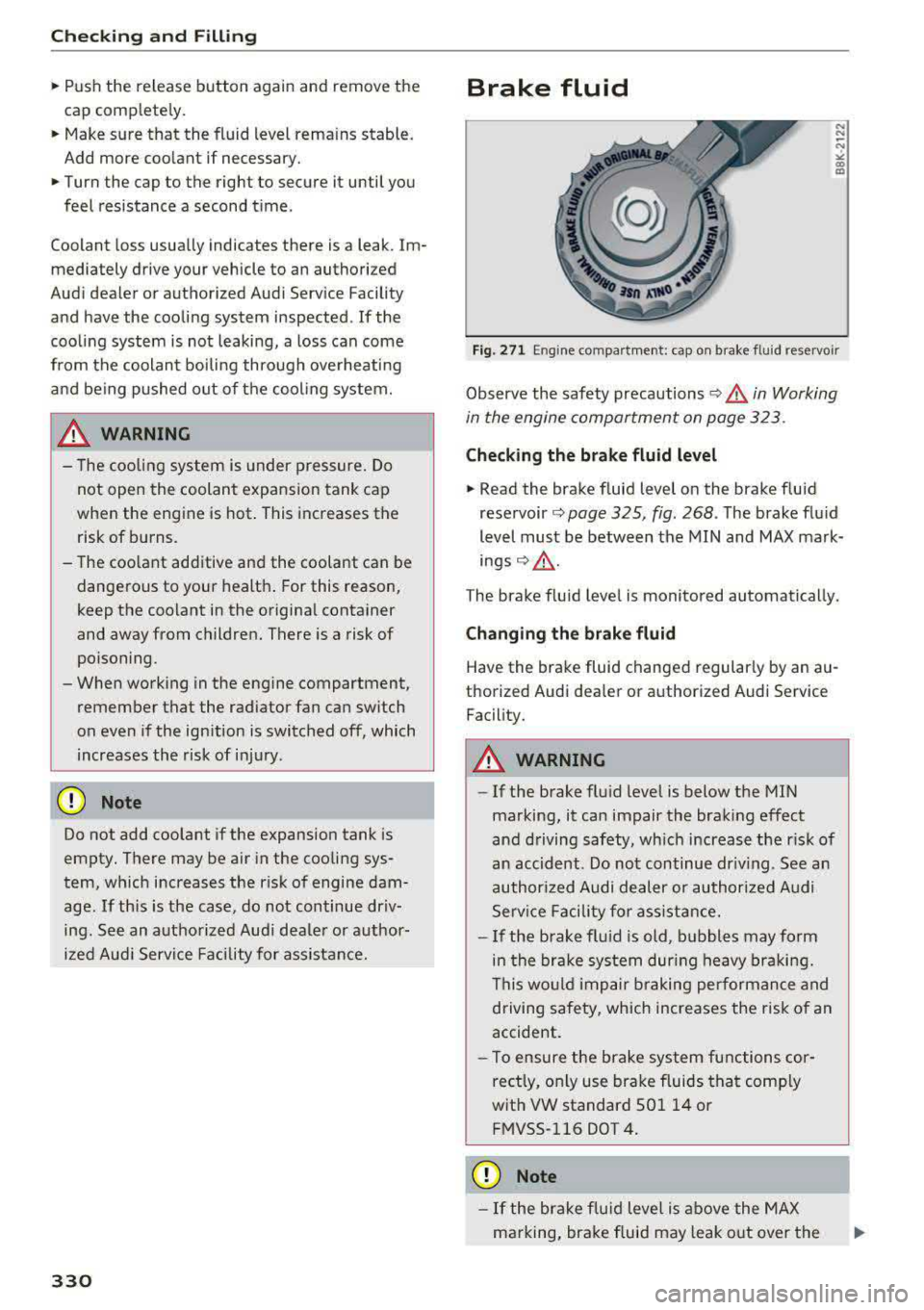
Checking and Filling
.,. Push the release button again and remove the
cap comp lete ly .
.,. Make sure that the fluid level rema ins stable.
Add more coolant if necessary .
.,. Turn the cap to the right to secure it until you
feel resistance a second t ime.
Coolant loss usually indicates there is a leak . Im
mediately drive your vehicle to an authorized
Audi dealer or authorized Audi Serv ice Facility
and have the cooling system inspected . If the
coo ling system is not leaking, a loss can come
from the coolant boiling through overheating
and being pushed out of the cool ing system.
_& WARNING
- T he coo ling system is under pressure. Do
not open the coolant expansion tank cap
when the engine is hot. This increases the
risk of burns.
- The coo lant add itive and the coolant can be
dangerous to your healt h. For this reason,
keep the coolant in the origina l container
and away from children. There is a risk of poison ing.
- When working in the engine compartment, remember that the radiator fan can switch
on even if the ign ition is switc hed off, which
increases the risk of in jury.
(D Note
Do not add coolant if the expansion tank is
empty. There may be air in the cooling sys
tem, wh ic h increases the risk of engine dam
age.
If th is is the case, do not continue dr iv
ing . See an a uthorized Aud i dea le r or author
ized Aud i Service Fa cil ity fo r assistance.
330
Brake fluid
Fig. 271 En gine compa rtment: cap o n brake fluid reservo ir
Observe the safety precautions¢.&, in Working
in the engine compartment on page 32 3 .
Check ing the brake fluid level
.,. Read the brake fluid level on the brake fluid
reservoir ¢ page 325, fig . 268 . The brake flu id
level must be between the MI N and MAX ma rk
ings ¢.&, .
The brake f lu id level is monito red automatically.
Changing the brake fluid
Have the brake fluid changed regularly by an au
thorized Audi dea ler or authorized Audi Service
Facility.
_& WARNING -
- If the brake flu id leve l is below the MIN
marking, it ca n impair the brak ing effect
and driving safety, wh ich increase the r isk of
an accident. Do not continue dr iv ing . See an
author ized Audi dealer or au thori zed Audi
Serv ice Facility fo r ass ist ance.
- I f the brake fl uid is old, b ubbles may form
in the bra ke system dur ing heavy bra king.
This wo uld im pair b raking per formance and
driving safety, which increases the risk of an
accident.
- To ensure the brake system functions cor
rectly, only use bra ke fluids tha t comp ly
wit h VW standard 50 1 14 or
FMVSS- 116 DOT 4 .
(D Note
-If the bra ke f lu id leve l is ab ove the MAX
marking, bra ke fluid may le ak o ut over the
Page 332 of 403
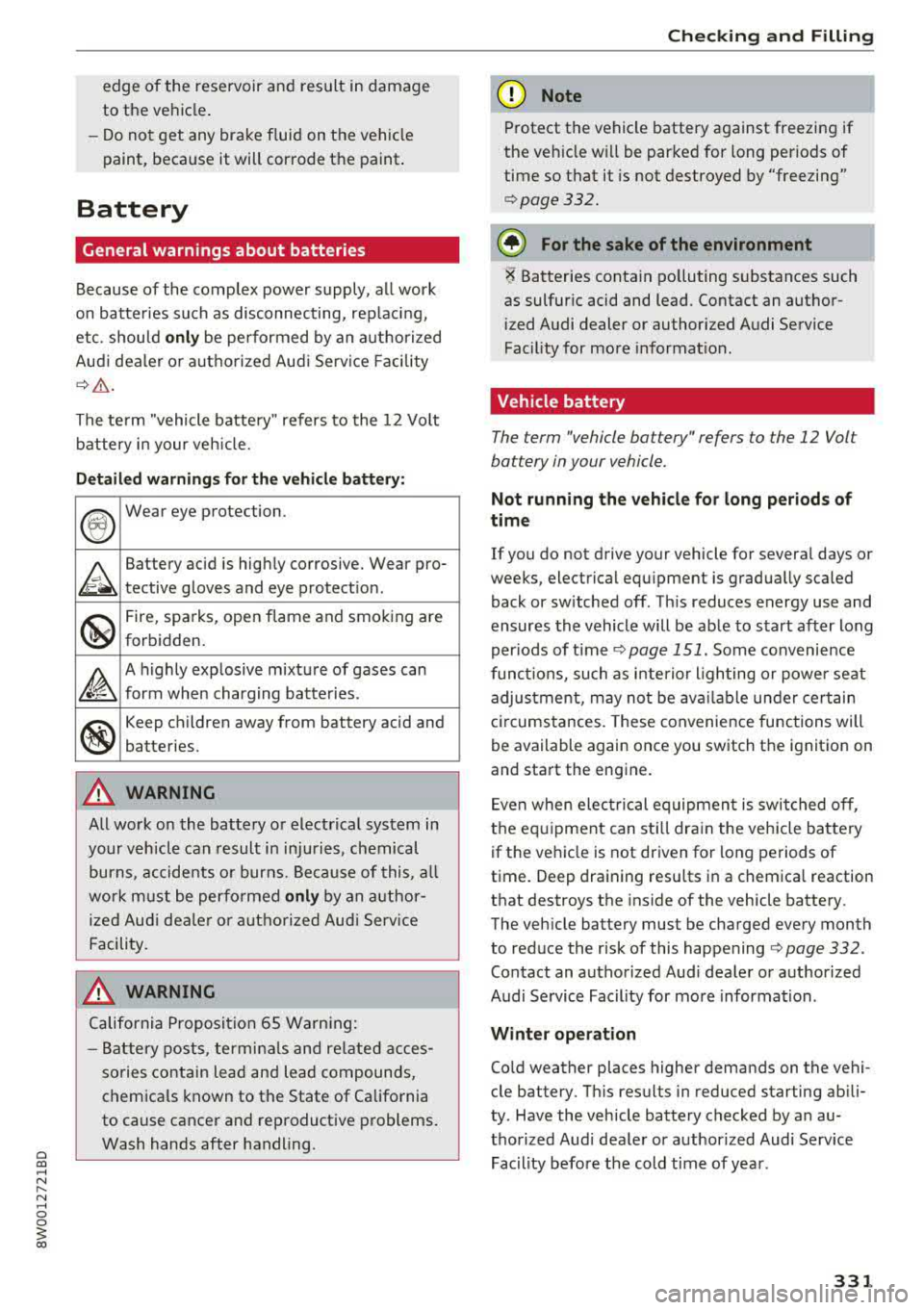
a co .... N ,....
N .... 0 0
3 co
edge of the reservoir and result in damage
to the vehicle .
- Do not get any brake fluid on the vehicle
paint, beca use it will corrode the paint .
Battery
General warnings about batteries
Because of the complex power supply, all work
on batteries such as disconnecting, replacing,
etc. shou ld
onl y be performed by an a uthorized
Aud i dealer o r autho rized Aud i Serv ice Facility
¢ ,&. .
The term "vehicle battery" refers to the 12 Volt
battery in your veh icle.
Detailed warning s for th e vehicl e batter y:
®
Wear eye protection .
A
Battery acid is highly corrosive. Wear pro-
tective gloves and eye protect ion.
@
Fire, spa rks, open flame and smoking are
forbidden.
~
A highly explosive mixture of gases can
form when charging batteries.
®
Keep children away from battery acid and
batteries.
A WARNING
All work on the battery or electrical system in
your vehicle can result in injuries, chemical
burns, accide nts o r burns. Be cause of this, a ll
work m ust be perfo rmed
only by an a uthor
ized Aud i deale r or a utho rized Aud i Serv ice
Facility.
_&. WARNING
California Proposition 65 Warning:
- Battery posts , termina ls and re lated acces
sories contain lead and lead compounds,
chemicals known to the State of California
to cause cancer and reproductive problems.
Wash hands after handling.
Ch eck ing and Filling
(D Note
Protect the vehicle battery against freezing if
the veh icle w ill be parked for long periods of
time so that it is not destroyed by "free zing"
¢ page 332.
@ For the sa ke of the environment
i Batteries contain polluting substances such
as sulfur ic acid and lead. Contact an author
i zed Audi dealer or authorized Audi Service
Fac ility for more informat ion .
Vehicle battery
The term "vehicle ba ttery" refers to the 12 Vol t
ba ttery in your vehicle.
Not running th e vehicle fo r long p eriod s of
time
If you do not drive your vehicle for severa l days or
weeks, electrical equ ipment is gradually scaled
back or sw itched off . Th is reduces energy use and
ensures the vehicle will be able to start after long
per iods of t ime
¢ page 151. Some convenie nce
funct ions, such as inte rio r ligh ting or power seat
adjustment, may not be ava ilable under certain
c ircumstances. These convenience functions will
be available again once you switch the ignition on
and start the engine.
Even when elect rical equipment is switched off,
the eq uipment can sti ll drain the vehicle battery
if the vehicle is not driven for long periods of
time. Deep draining results in a chemica l reaction
that destroys the inside of the vehicle battery .
The veh icle battery must be charged every month
to reduce the risk of this happening
¢ page 332 .
Contact an authorized Aud i dealer or authorized
Audi Service Facility for more information .
Winter operation
Co ld weather places higher demands on the vehi
cle battery. Th is results in reduced starting ab ili
ty. Have the vehicle battery checked by an au
thorized Audi dea ler or authorized Audi Service
Facil ity before the cold time of year.
33 1
Page 333 of 403

Checking and Filling
Charging the vehicle battery
Fig. 272 Engine co mpa rtment : connec tors for a c harger
and jump start cab le s
Req uirement: only use chargers with a m aximum
c hargi ng vo lta ge of 30 amp s/14.8 Volt s.
The
vehicle battery cables remain connected .
.,. Read the warnings c> .&. in General warnings
about batteries on page 331
and c> ,&. .
.,. Switch off the ignition and all electrical equip
ment .
.,. Open the hood 9 page 324 .
.,. Open the red cover on the positive terminal
c>fig. 272 .
.,. Clamp the charger terminal clamps to the jump
s ta rt pin s
according to the instruct ions . (pin
under the red cover = "positive ", p in with hex
agonal head= "negative ") .
.,. Inse rt the powe r cable for the charg ing device
i nto the socke t and switch the dev ice on .
.,. At the end of the charging process , switch the
charger off and pull the power cab le out of the
socket .
.,. Remove the charger terminal clamps.
.,. Close the red cover on the positive terminal.
.,. Close the hood c> page 324 .
A WARNING
-A highly explosive mixtu re of gases can form
when cha rging batter ies. On ly charge the
vehicle batte ry in well-ven tilated areas.
- A drai ned vehicle battery can freeze at tem
peratu res a round 32
QF (0 QC). A froze n or
thawed veh icle bat tery must not be charged
and must not be used anymore. The ba ttery
housing can crac k and battery acid can leak
o ut if ice forms, wh ich increases the r isk of
an exp losion and chemical burns. Contact an
332
author ized Audi dealer or authorized A udi
Service Facility for more information.
- Do not connect or disconnect the charging
cable whi le charging because this increases
the risk of an explos ion.
@ Tips
- Only charge the vehicle battery t hrough the
connect ions in the engine compartme nt.
- Read all of the manufacturer's instructions
for the charger before charging the vehicle
battery.
Windshield washer system
Fi g. 2 7 3 Engine compar tm ent: washer flui d res ervoir cap
The windshield washer fluid reservoir¢ contains
t he cleaning solution for the windshield and th e
headlight washer system *
c> page 325, fig. 268 .
The reservoir capaci ty can be found in
c> page 381.
To reduce the risk of lime scale deposits on the
spray no zzles, use clean water with low amounts
of calcium . Always add w indow cleaner to the wa
ter . When the outside temperatures are cold, an
anti -freezing agent should be added to the water
so that it does not freeze .
(D Note
-The concentration o f ant i-freez ing agent
must be adjusted to the ve hicle operat ing
conditions in the respective climate . A con
cent ration t hat is too high can lead to vehi
cl e damage.
- Never add radiator anti-freeze or other addi
t ives to the washer fluid.
Page 340 of 403

0 C0 .-< N ..... N .-< 0
~ a:,
Rim
means a metal support for a tire
or a tire and tube assembly upon
which the tire beads are seated.
Rim diameter
means nominal diameter of the
bead seat. If you change your
wheel size, you will have to pur
chase new tires to match the new
rim diameter.
Rim size designation
means rim diameter and width.
Rim width
means nominal distance between
rim flanges .
Sidewall
means that portion of a tire be
tween the tread and bead .
Speed rating (letter code)
means the speed at which a t ire is
designed to be driven for extend
ed periods of time . The ratings
range f rom 93 mph (150 km/h)
to 186 mph (298 km/h)
¢ table
on page 335.
You may not find
this information on all tires be
cause it is not required by law.
The speed rating letter code ,
w here applicable, is molded o n
the tire sidewall and indicates the
Wheels
maximum permissible roa d
speeds
¢ A in Winter tires on
page 349.
Tire pressure monitoring
system
means a system that detects
when one or more of a vehicle's
ti res are underinflated and illumi
na tes a low tire pressure warning
telltale.
Tread
means that po rtion of a ti re that
comes i nto contact with the road .
Tread separation
means pulling away of the tread
from the tire carcass.
Treadwear indicators (TWI)
means the projections withi n the
principa l grooves desig ned to g ive
a visua l indication of the degrees
of wear of the t read. See
¢ page 343, Treadwear indicator
for mo re in fo rmat ion on meas ur
ing t ire wear .
Uniform Tire Quality Grading
is a tire information system devel
oped by the United Sta tes Nation
a l Highway Traffic Safety Admin
istration ( NHTSA) tha t is designed
to help buyers make re lat ive
339
..
Page 343 of 403
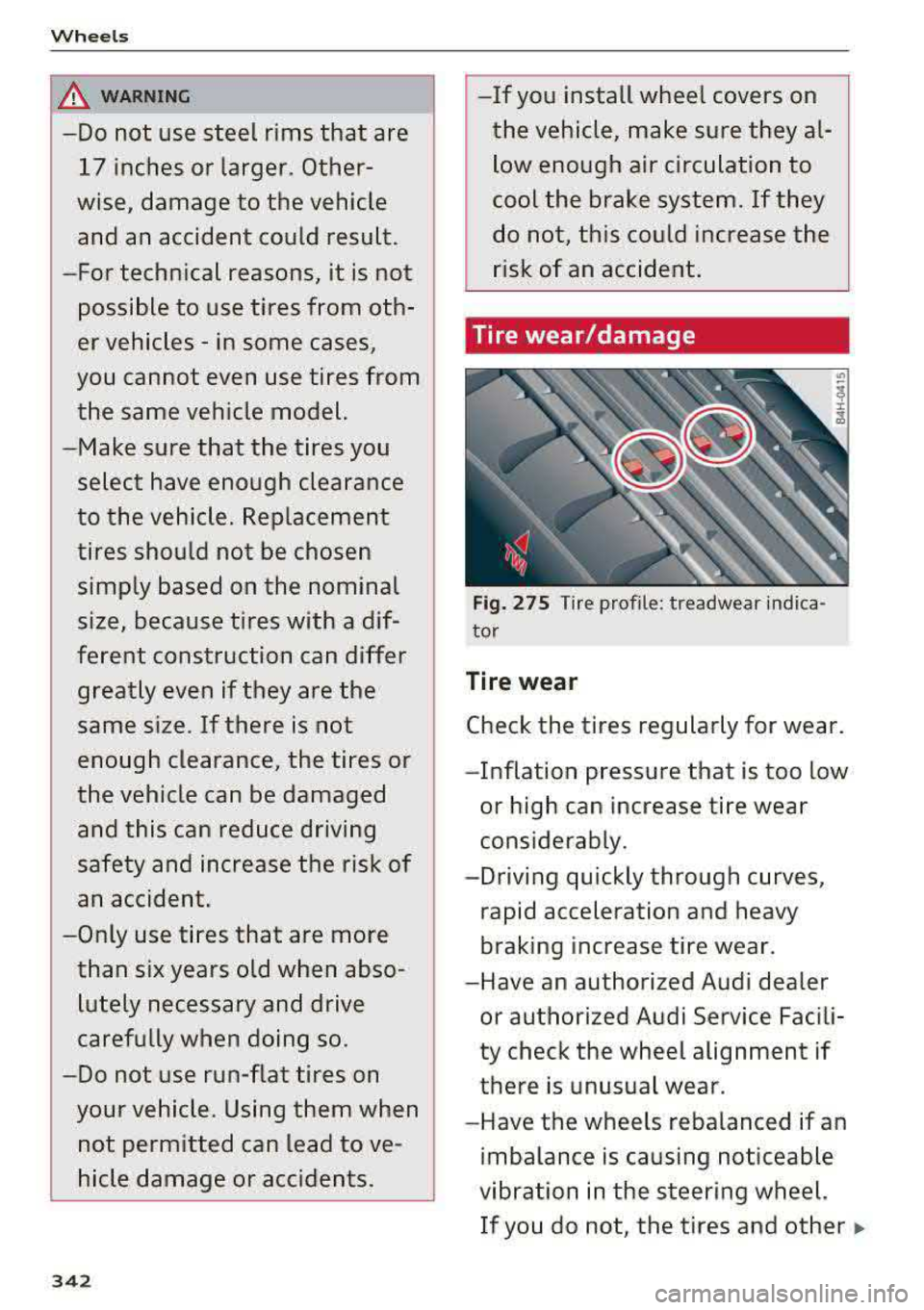
Wheels
&,. WARNING
-Do not use steel rims that are 17 inches or larger . Other
wise, damage to the vehicle
and an accident could result.
-For technical reasons, it is not
possible to use tires from oth
er vehicles - in some cases,
you cannot even use tires from
the same vehicle model.
-Make sure that the tires you
select have enough clearance
to the vehicle. Replacement
tires should not be chosen
simply based on the nominal
size, because tires with a dif
ferent construction can differ greatly even if they are the
same size . If there is not
enough clearance, the tires or
the vehicle can be damaged
and this can reduce driving
safety and increase the risk of an accident.
-Only use tires that are more than six years old when abso
lutely necessary and drive
carefully when doing so .
-Do not use run-flat tires on your vehicle. Using them when
not permitted can lead to ve
hicle damage or accidents.
342
-If you install wheel covers on the vehicle, make sure they al
low enough air circulation to
cool the brake system. If they
do not, this could increase the
risk of an accident.
Tire wear /damage
Fig. 275 Tire profile: treadwear indica
tor
Tire wear
Check the tires regularly for wear.
-Inflation pressure that is too low
or high can increase tire wear
considerably.
- Driving quickly through curves,
rapid acceleration and heavy
braking increase tire wear.
-Have an authorized Audi dealer or authorized Audi Service Facili
ty check the wheel alignment if
there is unusual wear .
-Have the wheels rebalanced if an
imbalance is causing noticeable
vibration in the steering wheel. If you do not, the tires and other
..
Page 344 of 403
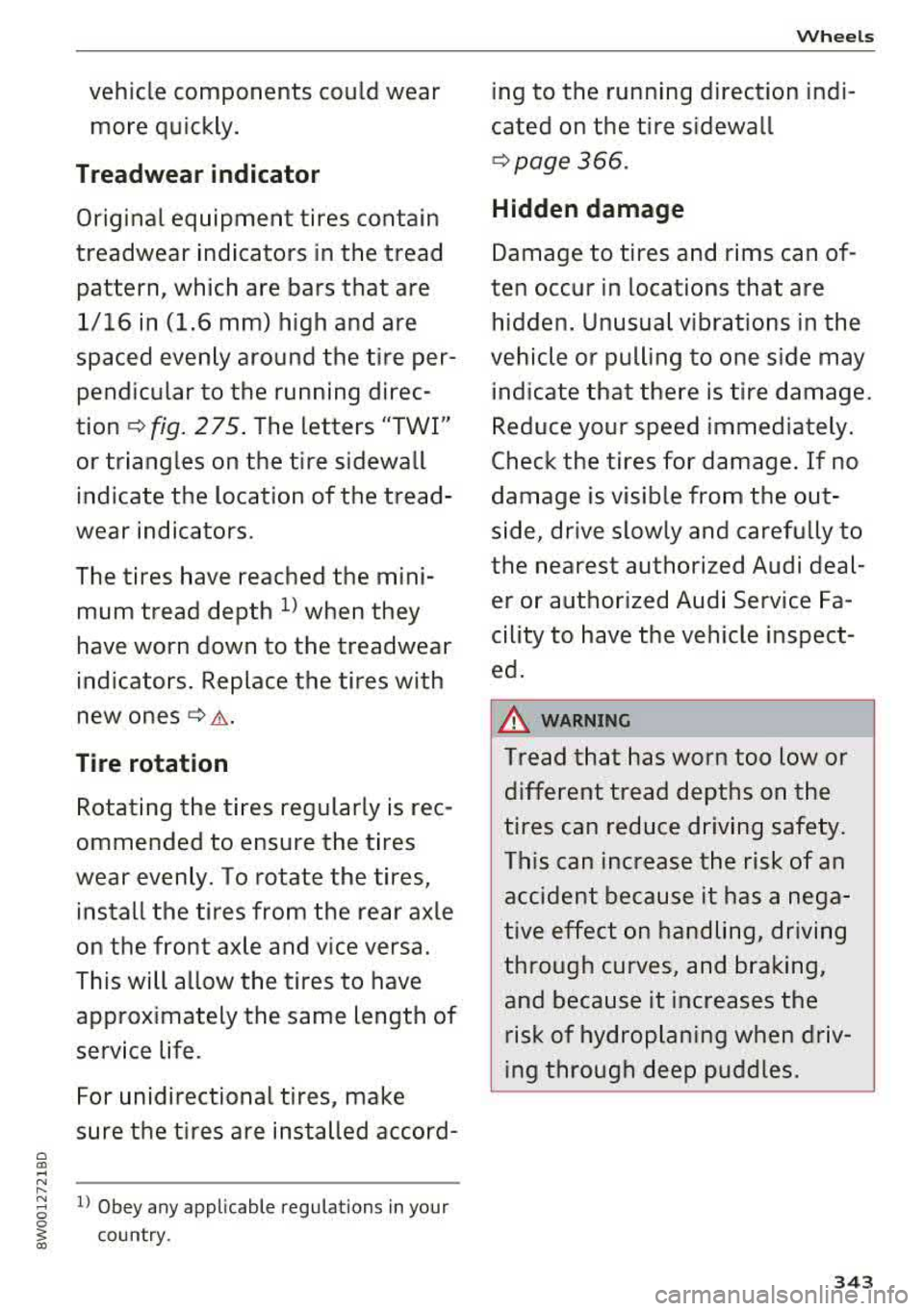
0 C0 .-< N ,...
vehicle components could wear more quickly.
Treadwear indicator
Original equipment tires contain
treadwear indicators in the tread pattern, which are bars that are
1/16 in (1.6 mm) high and are
spaced evenly around the tire per
pendicular to the running direc
tion¢ fig. 275. The letters "TWI"
or triangles on the tire sidewall indicate the location of the tread
wear indicators.
The tires have reached the mini mum tread depth
l) when they
have worn down to the treadwear
indicators. Replace the tires with
new ones
¢ A.
Tire rotation
Rotating the tires regularly is rec
ommended to ensure the tires
wear evenly. To rotate the tires,
install the tires from the rear axle
on the front axle and vice versa.
This will allow the tires to have
approximately the same length of
service life.
For unidirectional tires, make
sure the tires are installed accord-
8 l) Obey any applicable regulations in your
! country.
Wheels
ing to the running direction indi
cated on the tire sidewall
¢ page 366 .
Hidden damage
Damage to tires and rims can of
ten occur in locations that are hidden. Unusual vibrations in the
vehicle or pulling to one side may indicate that there is tire damage.
Reduce your speed immediately.
Check the tires for damage. If no
damage is visible from the out
side, drive slowly and carefully to
the nearest authorized Audi deal
er or authorized Audi Service Fa
cility to have the vehicle inspect
ed.
A WARNING
Tread that has worn too low or
different tread depths on the
tires can reduce driving safety.
This can increase the risk of an
accident because it has a nega
tive effect on handling, driving
through curves, and braking,
and because it increases the
risk of hydroplaning when driv
ing through deep puddles.
343